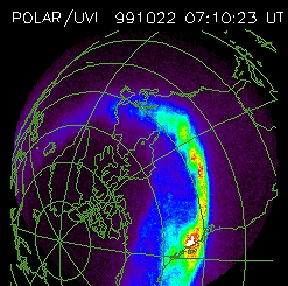October 25, 1999 Suitland, Maryland The sun erupted with a massive solar flare on Sunday evening, October 18. Three days later on October 21st, the flare's shock front of charged particles had rippled through space for 93 million miles and struck earth's magnetosphere. The collision of electrons and protons with upper atmospheric molecules created a dramatic glow called aurora borealis or Northern Lights. The magnetic storm was strong over Hudson Bay, the Great Lakes and as far south as Ohio.
By October 22, NASA's Ultraviolet Imager on a polar spacecraft captured dramatic images of the earth's magnetic field interacting with the solar wind. Frequently, when viewed from space, a complete aurora will appear as a circle around one of the earth's magnetic poles. This recent October display was more concentrated in a band along the northern United States.

Click here to subscribe and get instant access to read this report.
Click here to check your existing subscription status.
Existing members, login below:
© 1998 - 2025 by Linda Moulton Howe.
All Rights Reserved.

